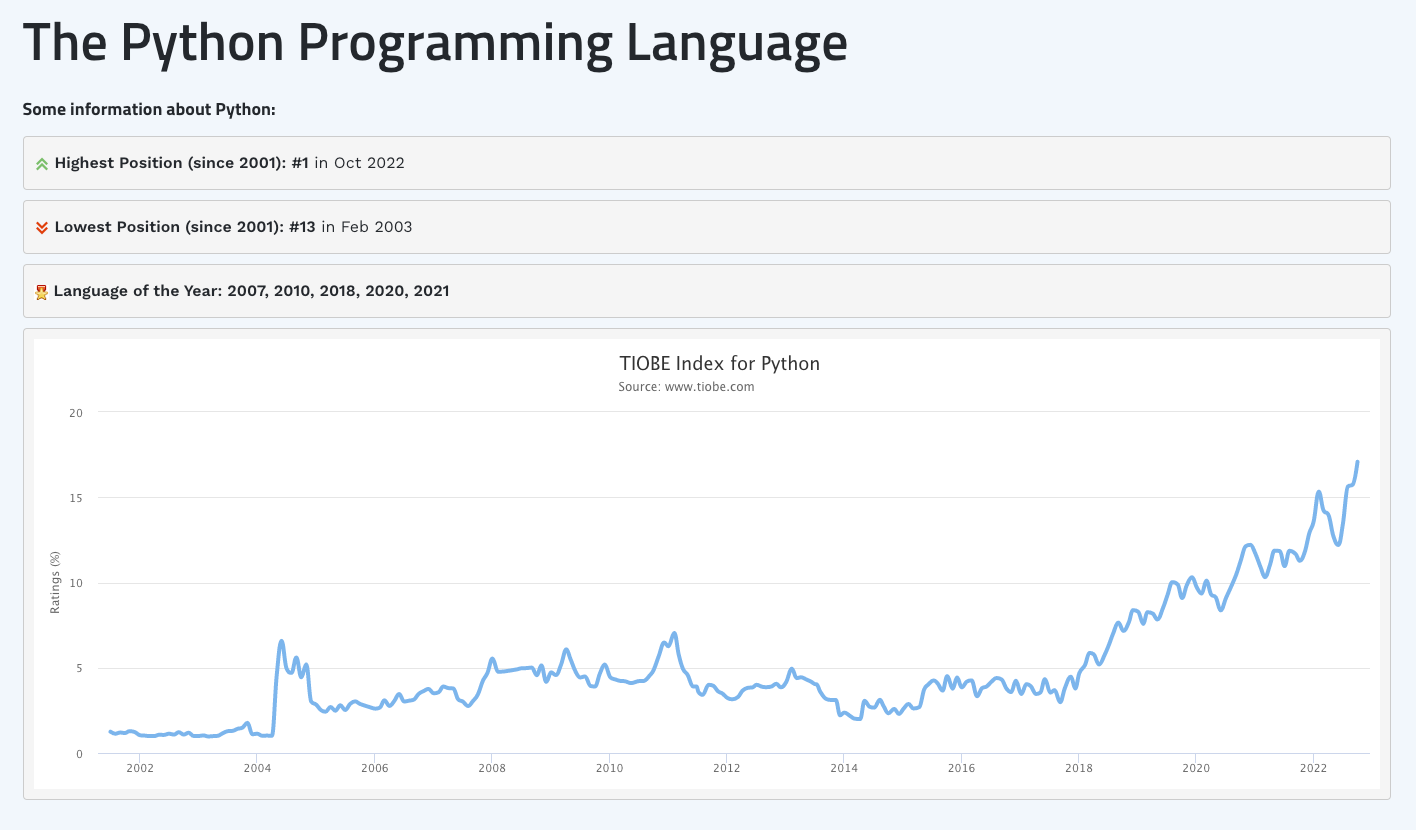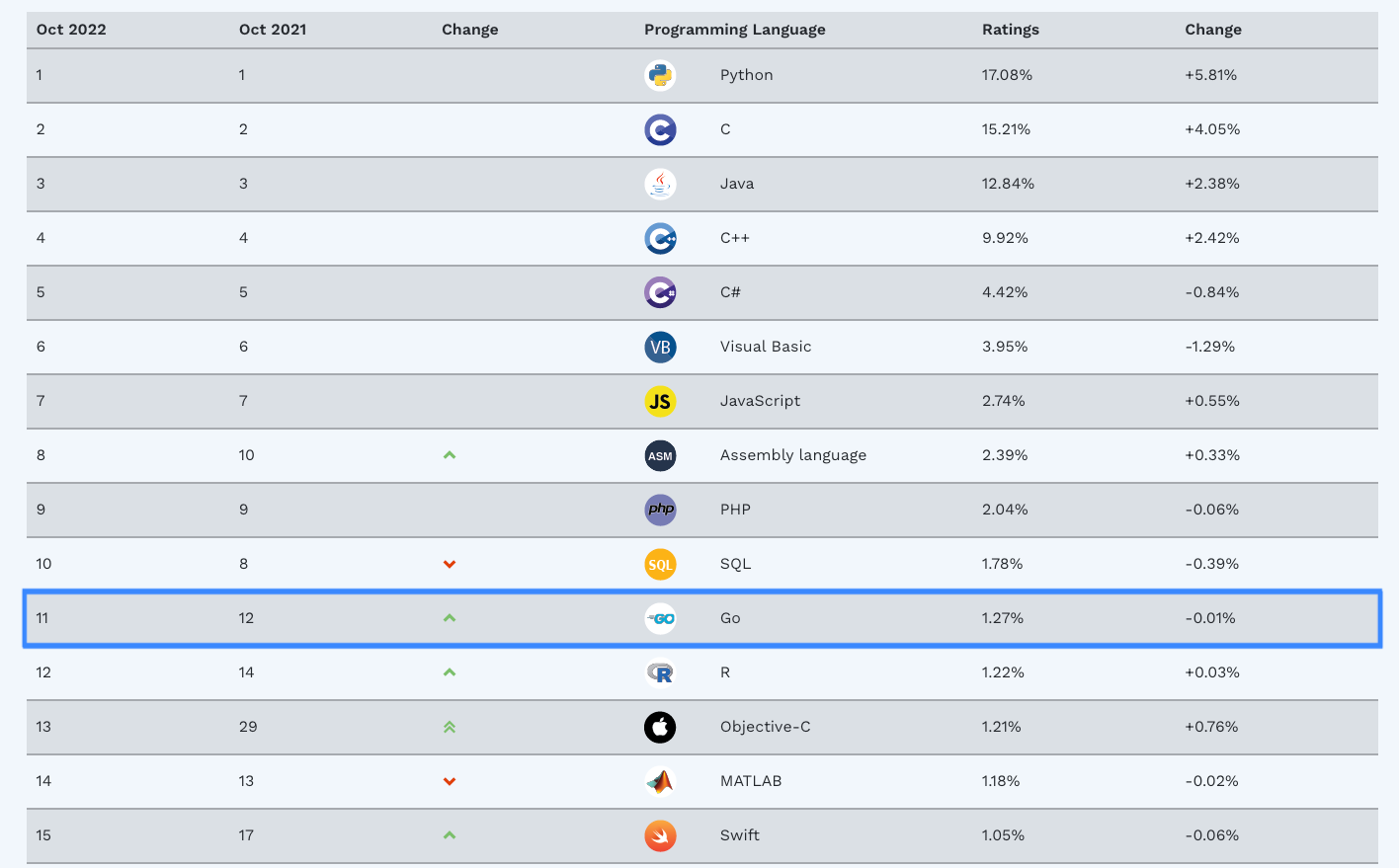Written by Yanick
Launching an IT project can be a headache in many ways. There’s a plethora of issues to address even before you start off. One of the most critical is deciding on the programming language. You need to consider a number of factors to figure out how a given language aligns with the project’s type and goal.
On the technical end, it’s necessary to include the targeted platform, the availability of relevant frameworks, the elasticity of the language, its performance, and a few other issues. Some questions, though, extend beyond the technical domain, for example, the availability of skilled developers or the size of the community supporting the code.
The right choice comes with sweet benefits. It helps save costs, reduce time to market, and deliver a better, more efficient product. The not-so-right one probably won’t kill the project but will make it more costly and time-consuming to get things done. It may also impact the base quality of the software.
Python vs. Golang. The two programming languages on the rise
Typically, there’s not much hesitation concerning the frontend, as the number of relevant programming languages is pretty small, and so is the risk of a wrong choice. But at the backend, things get more complex. The options are plenty. Each one has advantages and downsides. Plus, the situation is fluid, with some technologies gaining wider support and some slowly fading.
In recent years, the two languages have garnered a lot of attention from the industry and experienced significant growth in their respective communities: Python and Golang. Their fame is well-deserved. Both these languages are powerful tools for creating a wide range of high-demand solutions – each with its advantages and limitations.
Let’s compare their strengths, weaknesses, and typical applications to find out how they’re different and how to get the best of them.
Python programming language: syntax clarity, increased productivity
Python is a dynamically-typed general purpose programming language with English-like syntax. Often referred to as an object-oriented language, it is, in fact, a multi-paradigm one. Python boasts impressive clarity compared to other programming languages, which is one reason it has been almost the default choice for many novice programmers. Its readability helps to increase productivity across development teams because it facilitates reading, writing, modifying, and reusing code.
Conceived in 1989 by Guido van Rossum (and named after the cult comedy group rather than a snake), Python has accrued an immense following over the years, and in 2021 it first topped the TIOBE index of programming language popularity. In 2022, it stays ahead of C, Java, C++, C#, JavaScript, and a whole array of other programming languages.

Nowadays, Python is used in almost every field of programming – with possibly the sole exception of safety-critical embedded systems, which require faster solutions. As both a compiled and interpreted language, it is first compiled and then interpreted with an accompanying script, which affects the speed of code execution. Describing Python as slow would be a plain overstatement, but there are indeed faster languages.
Golang: superfast and lightweight programming language
One of them is Go – sometimes referred to as Golang (we’re using both names interchangeably for language convenience) because of its former domain Golang.org, now redirecting to Go.dev. It is a more recently developed language, designed by Google engineers in 2007, publicly announced in 2007, and released as version 1.0 in 2012. According to its creators, Go “combines the development speed of working in a dynamic language like Python with the performance and safety of a compiled language like C or C++.”
Unlike Python, Go is a compiled, strongly statically typed language. Go programs compile really fast and produce single, self-contained, small binaries. In terms of speed, Golang easily outperforms interpreted languages and wins the “Go vs. Python” rivalry. According to runtime performance tests, Go can run up to 40 times faster than its competitor.
Even though the Go language has a way to go (pun intended) to reach the top of the TIOBE index, it is constantly crawling up the ladder. Valued for its speed, high security, and modularity, it enjoys a fast-growing Go community, and it is used by a slew of big companies and institutions worldwide, including Alibaba, Amazon, Booking.com, Facebook, Google GOV.uk, or Uber.

What is Python code used for? Web development, machine learning, AI
As a general-purpose language, Python is one of the “hidden forces” in today’s internet, lurking in websites, gaming software, business apps, web servers, AI algorithms, data science tools, and more. It is used in many fields and in many ways. Python fully supports object-oriented and structured programming, with some of its features and extensions supporting functional, aspect-oriented, logic, and other types of programming.
The language offers a comprehensive standard library but was designed to be extensible via modules. In three decades of its existence, the technology has yielded an impressive number of libraries and powerful frameworks that speed up the development process. As of September 2022, the Python Package Index (a repository of software for the Python programming language) contains over 400 thousand packages for all sorts of applications, including communications, data analytics, desktop environment, games, home automation, multimedia, security, and many more.
With the scope of applications enabled by Python and its modules, pointing to a few areas of focus might seem arbitrary. However, there are domains where Python excels.
Web development
Python is a common choice for web development, primarily due to relevant frameworks like Django and Pyramid and microframeworks like Flask and Bottle. Typically, Python is used for dealing with the backend. A less-known fact is that it also works as a front-end language. In May 2022, project Anaconda introduced PyScript, a framework enabling users to create Python programs with an HTML interface.
Artificial intelligence and machine learning
Python is considered among the top programming languages for AI and ML development. Due to the simplicity and learnability of its syntax, it enables developers to deal faster with complex algorithms and big data. Python provides excellent libraries for AI/ML and deep learning applications, such as Keras, NumPy, Pandas, PyTorch, TensorFlow, or Theano. It’s also worth noting that most AI frameworks provide direct support for Python.
Data science and data visualization
Python is widely used in the research area for scientific and business purposes. It is favored over other languages due to its simplicity and compact nature, as it allows one to accomplish tasks with fewer lines of code. As with different use cases, Python offers excellent libraries for processing and visualizing data, especially NumPy, Pandas, and Matplotllib.
Blockchain
Python is also a good fit for the “crypto” industry. Its conciseness allows for building a rudimentary blockchain in less than fifty lines of code. Python, as an open-source programming language, has huge support and offers free resources for practically any issue related to blockchain development.
Industrial automation
Python has grown from the domain of commercial applications into the world of industrial and manufacturing processes. Python-based programs handle testing, data collection, task automation, database management, numerical analysis, etc. As a machine learning-enabler, Python is also used in predictive maintenance, computer vision, and autonomous robotics.
Financial data analysis
The Python language is good at crunching big numbers and big data, making it a perfect language for financial data analysis and modeling. The most valuable libraries for these applications include NumPy, SciPy, Pandas, statsmodel, Quandl, and Pyfolio.
What is the Go language used for? Cloud systems, networked services, multimedia
Go is in many ways different than Python and more niche. It was designed with scalability and reliability in mind to deal with the hurdles posed by the growing cloud infrastructure at Google. Its makers, frustrated with the overcomplicated nature of C++, wanted to create an efficient programming language for managing large-scale projects. They combined Python’s simplicity, Javascript’s abundance of useful features, and C’s disciplined syntax to concoct a much improved and easier-to-use successor to C++.
Thanks to its unique features and thriving community, Golang has become a vital component of the modern cloud computing environment and one of the most effective technologies for large-scale infrastructure. It’s extensively used for system programming and developing server-side applications. It has also proved its efficiency in solving data science problems and creating AI algorithms.
Let’s name a few areas where Go’s strengths shine.
Distributed networked services
Go has a neatly designed standard library for common tasks with built-in functions for network programming. It natively supports concurrency (allowing multiple tasks to progress simultaneously) and parallelism (allowing multiple tasks to be executed simultaneously), which makes it a perfect tool for creating highly networked and concurrent software. Go is naturally suited for developing web servers, REST applications, or mini frameworks for web apps.
Scalable cloud computing systems
Owing to its speed and rich support for managing concurrency with goroutines and channels, Golang is an excellent language for developing efficient cloud-native software and microservices. The major cloud providers using Go in their services are AWS, Azure, and, obviously, GCP.
Web development
Go offers a lightweight, straightforward environment and handy tools for building web applications, enabling the swift development of scalable software. It also comes with a secure and easy-to-use web server and a web templating library.
Command line interface (CLI)
Go is a convenient tool for designing elegant command line interfaces (text-only, unlike GUIs), extensively used in cloud and infrastructure applications. Prime examples are the Docker CLI or kubectl for Kubernetes.
Artificial Intelligence and machine learning
In recent years, Golang has become a mainstream programming language for artificial intelligence and machine learning, including deep learning. Its compiling efficiency and low execution time enable extensive mathematical calculation, a crucial condition for AI and ML development. Go also offers useful libraries for developing AI and ML applications, such as GoLearn, Goml, and Hector.
Multimedia platforms
Go’s support for multi-threaded concurrency and maximizing CPU usage is a huge asset in projects involving massive multimedia websites. With its immense scalability, Go is also effective for creating social media apps that need to handle tons of traffic. Services using Golang as the core language include Dailymotion, Netflix, Soundcloud, and YouTube.
Golang vs. Python: how are they different?
One of the key differences between Golang and Python lies in the range of their applications. Python is used on a much wider scale, while Golang is more niche. There are domains where both these languages overlap. However, Python’s scope of use is still greater than Golang’s, and so is the number of Python libraries and frameworks, Python-related learning resources, and community support. This divergence results from the age discrepancy of both programming languages but also reflects their structural and functional differences.
Python is a dynamically typed language. The interpreter doesn’t know the variables’ types “beforehand,” as they are determined only during runtime. Such a feature increases the ease of coding but slows down code execution. On the other hand, Go is a statically typed language, but it has a dynamic-like quality thanks to a small syntactic overhead. It’s worth mentioning that both Python and Golang are strongly typed: they enforce strong restrictions on typing to prevent implicit conversions between unrelated types.
One of Go’s main strengths is its native parallelism and concurrency support, and it beats Python in this regard. The latter also offers tools for managing these features, but they’re not included in the standard library. Go is widely recognized for handling both types of computation more efficiently.
A noteworthy difference is Python’s support for inheritance and Golang’s lack thereof. Inheritance increases code reusability and simplifies development, though it might decrease the execution speed – the quality at which Golang excels.
Regarding the core strengths of both languages and putting them to practical use, Go is perfect for systems programming and developing cloud systems, while Python works best for solving data science problems and developing machine learning applications.
There is plenty of other characteristics that distinguish both programming languages, such as the use of indentation. For practical reasons though, let’s skip less substantial technicalities and move on to naming key advantages and disadvantages of both Python and Golang.
What are the key advantages of Python?
It has simple, English-like syntax
This great feature translates to ease of writing Python code and speeding up the development process. It also attracts new developers and helps to grow the talent pool as well as increase the number of available resources.
It offers an insane amount of modules
Not only does Python come with dozens of neat in-built functions, but also it has a massive amount of libraries and frameworks that provide solutions to virtually any programming problem and expedite the development process.
It is dynamically typed
Python doesn’t require declaring data types when writing code, which is a relief for developers and time efficiency for the project.
It promotes code reusability
Python supports object-oriented programming and inheritance, promoting code reusability and minimizing the need for duplication, according to the DRY (don’t repeat yourself) concept. It simplifies development and maintenance costs, as changes introduced to the base class are automatically implemented in the derived classes.
It is great for machine learning
With its conciseness, readability, flexibility, dedicated libraries, and vast, knowledgeable community, Python is a perfect tool for developing machine learning applications and handling big data structures.
What are the key advantages of Golang?
It’s clean and concise
Although more verbose than Python, Go is still clean, concise, and efficient. As a result, it enables writing programs that are easy to read, understand, and modify. In terms of business, it saves time and money.
It’s really fast
As a compiled programming language, Go beats Python in terms of speed and is a worthy rival of Java. It compiles to machine code extremely fast and allows processing tasks with extraordinary efficiency, especially in programs that leverage Go’s native concurrency.
It has native support for concurrency
Golang has an in-built concurrency mechanism and can handle concurrent processes with outstanding efficiency. As a result, it allows for a significant improvement in performance by leveraging multiple processing cores.
It makes scaling easy
Go was designed with scalability in mind. With its concurrency support, efficient memory management, and compact syntax, Golang is terrific for scaling. For the same reasons, it’s perfect for developing microservices-based applications that enable more efficient scaling than monolithic ones.
It’s well-suited for large projects
As a right fit for microservice architecture, Golang is frequently a programming language of choice for building large, scalable, and data-intensive systems. These type of projects require engagement from multiple developers and frequently involve changing development teams. Go’s simplicity (learnability) and extensive support facilitate onboarding new programmers.
What are the main disadvantages of Python?
It’s not fast enough
In Python, speed is not the main asset. As a high-level interpreted language, it’s not compiled directly into machine code. As a result, it is less efficient in executing a program than, say, Go or other compiled languages.
It’s not memory-efficient
Python may have some cool features for optimizing memory utilization, but it’s not a memory-efficient language. Python programs are run via an interpreter, which means they use more memory than any equivalent program written in a compiled language like Go or C.
It’s not the best choice for mobile apps
Python is basically a server-side language and not an ideal tool for mobile app development. One reason is its relatively low speed, another – the memory usage. The language has made some progress with libraries like Kivy and Beeware, but it still has a long way to go to compete in mobile computing.
It scores low on database handling
While Python is great as a coding language, it falls short with regard to accessing databases. Its layers for establishing communication between a backend service and a database are considered too rudimentary and weaker compared to other technologies like Java Database Connectivity or Open Database Connectivity.
What are the main disadvantages of Golang?
It doesn’t have as many libraries
Golang is a relatively new language. It has a passionate and dynamically growing community. Nevertheless, it’s nowhere near Python in terms of resources, such as libraries and frameworks. So, in this case, the Golang vs. Python score is 0:1.
It doesn’t support inheritance
Golang doesn’t have the concept of class, hence it doesn’t support inheritance. This characteristic goes against the DRY principle and limits code reusability.
It has dependency management issues
Golang has a problematic approach to dependency management, which often results in conflicting package requirements. Another issue is that available Go’s dependency managers aren’t complete solutions and are different regarding supported features.
Its error-handling method is troublesome
Again, Go has an untypical approach to error handling, quite different from the “try” pattern most programmers got used to over the years. The Go community considered an update but gave it a pass so as not to warp other parts of the language.
If you’re still unsure which programming language would best match your project, don’t hesitate to contact us. We’ll be happy to help!





